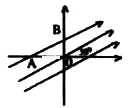An electric field of 20N/C exists along the x-axis in space. Calculate the potential difference VB−VA where the points A and B are given by
a. A=(0,0),B=(4m,2m)
b. A=(4m,2m),B=(6m,5m)
c. A=(0,0),B=(6m,5m).Solution in Tamil
(a)A=(0,0)B=(4,2)E=20N/C
So,vb−vaE.d=20×(0−4)
(b)A=(4m,2m),B=(6m,5m)
⇒vb−va=e×d
=20×(4−6)2
=20×(−2)=−40vo<.
(c)A=(0,0),b=(6m,5m)
⇒vb−va=e×d
20×(0−6)2
=20×(−6)=120vo<.
Thus potential difference between (0,)and(4,2)is,
dV=−E.dx=−20×4
=−80vo<.
Potentiale≠rgy(ub−ua)betweentheponts=dv×q
Topper's Solved these Questions
- ELECTRIC FIELD AND POTENTIALBOOK - HC VERMACHAPTER - ELECTRIC FIELD AND POTENTIALEXERCISE - Objective 2
8 Videos
- ELECTRIC CURRENT THROUGH GASESBOOK - HC VERMACHAPTER - ELECTRIC CURRENT THROUGH GASESEXERCISE - Exercise
23 Videos
- ELECTROMAGNETIC INDUCTIONBOOK - HC VERMACHAPTER - ELECTROMAGNETIC INDUCTIONEXERCISE - EXERCISE
98 Videos
Similar Questions
Mart out the correct options
View SolutionA discharge tube contains helium at a low pressure. A large potential difference is applied across the tube. Consider a helium atom that has just been ionized due to the detachment of an atomic electron. Find the ratio of the distance travelled by the free electron to that by the positive ion in a short time dt after the ionization.
View SolutionCalculate the dimensions of (a) ∫→E.d→l,(b)vBlanddΦ0dt. The symbols have their usual meanings.
View SolutionAssume that an electric field →E=30x2ˆj exists in space. Then the potential difference VA−VO, where VO is the potential at the origin and VA the potential at x=2m is:
View SolutionIn a certain region, electric field E exists along the x - axis which is uniform. Given B = 2 sqrt(3) m and BC = 4 m . Points A, B, and C are in x y plane. . Find the potential difference V_A - V_B between the points A and B .
View SolutionA uniform electric field exists in x−y plane. The potential of points A(−2m,2m),B(−2m,2m) and C(2m,4m) are 4V,16V and 12V respectively. The electric field is
View SolutionA uniform electric field of 30NC−1 exists along the X-axis calculate the potential difference VB−VA between the points A (4m,2m) and B(10m,5m).
View SolutionA uniform electric field is along x-axis. The potential difference V_(A)-V_(B)=10 V is between two points A (2m, 3m) and (4m, 8m). Find the electric field intensity.
View SolutionAn electric field of 10 N/C exists along the x-axis in space. Calculate the potential difference VB−VA where the points A and B are given by -
(a) A = (0, 0), B = (8m, 3m), (b) A = (8m, 3m) , B = (12m, 6m)
(c) A = (0, 0) , B = (12m, 6m)
View SolutionAn electric field of 20 N/C exists along the negative x-axis in space. Calculate the potential difference V_(B)-V_(A) , where the points A and B are given by : (a) A= (0, 0), B=(0, 4m) (b) A=(2m, 1m), B=(4m, 3m)
View SolutionAn electric field →E=Bxˆi exists in space, where B=20V/m2. Taking the potential at (2m, 4m) to be zero, find the potential at the origin.
View SolutionThe velocities of 4 molecules are 2m/s,4m/s,5m/sand6m/s respectively. What is their mean square velocity?
View SolutionThe velocities of 4 molecules are 4m/s, 5m/s, 6m/s and 2m/s respectively. What is their rms velocity?
View SolutionAssume that an electric field →E=30x2ˆi exists in space. Then the potential difference VA−VO, where VO is the potential at the origin and VA the potential at x=2m is:
View SolutionA field of 100Vm−1 is directed at 30° to positive x-axis. Find (VA−VB) if OA = 2m and OB = 4m

View SolutionGravitational field in x−y plane is given as
E=(2xˆi+3y2ˆj)N/kg
Find difference in gravitation potential between two points A and B, where
co-ordinates of A and B are (2m,4m)and(6m,0).
View Solution
